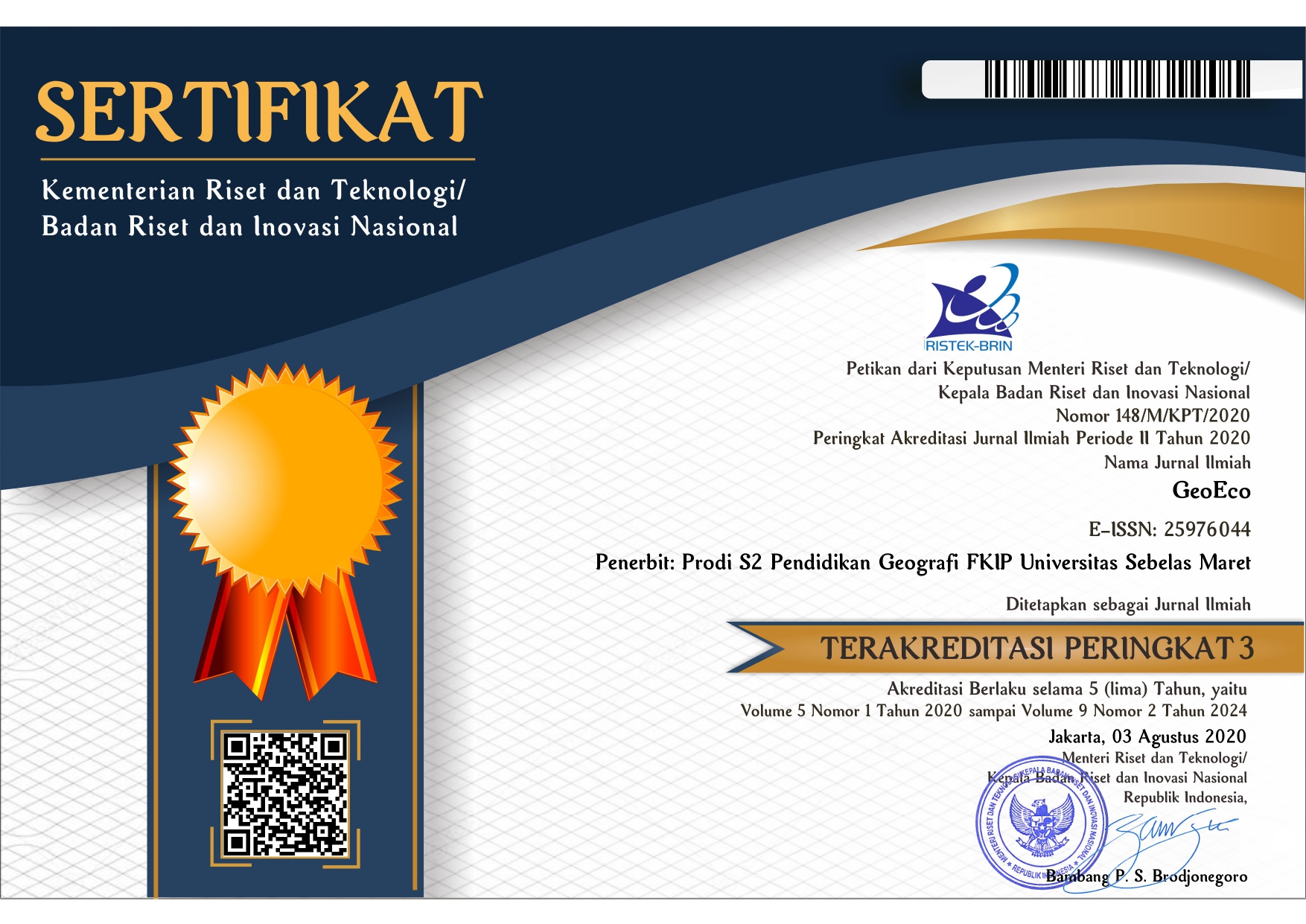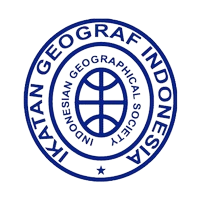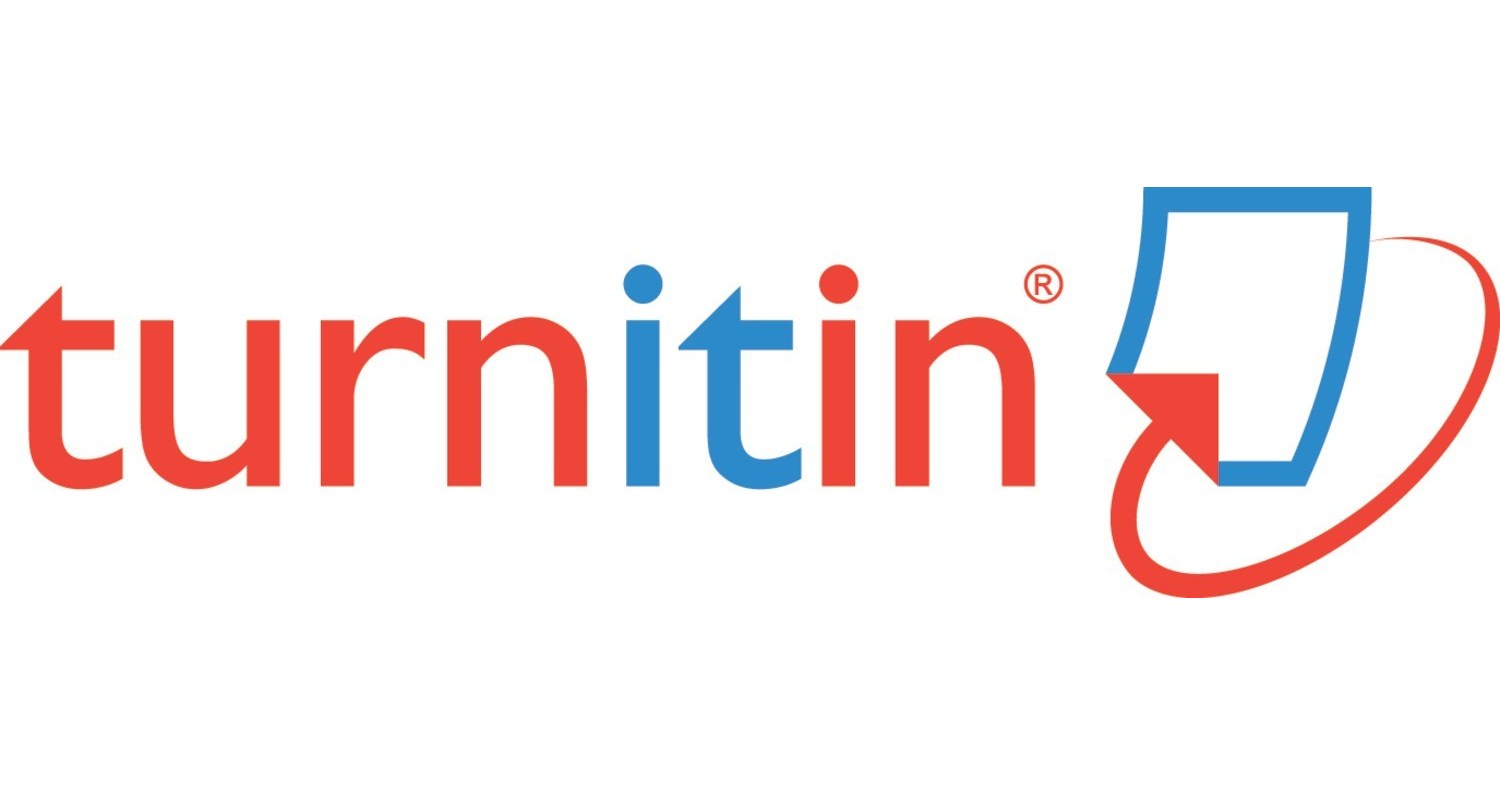Author Guidelines
Terms of manuscript submission
GeoEco is a peer-reviewed journal published by Faculty of Teacher Training and Education at Sebelas Maret University. GeoEco covers all fields of education and science related to geography and the environment. This journal aims to reveal facts, problems, and problem-solving that can be used as input for the Government, institutions, communities, and individuals. GeoEco journal accepts scientific research papers, review papers, and discussion papers related to environmental sustainability, geography science, and geography education. GeoEco is published twice a year, in January and July. Starting with Volume 9, No. 1 January 2023, GeoEco has adopted a new manuscript template. Authors are required to conform their manuscripts to this updated format before submitting.
The article is the result of the researcher's work, in the form of research results and critical studies (reviews) of the latest issues in the field of environmental sustainability, geography science, and geography education that have never been published in any journal (a statement of authenticity must be included in the article). Articles can be written in English, as many as 3000-8000 words. Articles are typed in Times New Roman 12 pt font and 1.5 spacing. The template is an A4 format with at least 3 cm left, right, top, and bottom margins. The header and footer shall be positioned 1,25 cm from the edge. All text paragraphs should be single-spaced. Double spacing should only be used before and after headings and subheadings. The position and style of headings and subheadings should follow this example. No spaces should be placed between paragraphs. For research manuscripts, the manuscript must contain several parts. The systematics are as follows:
1. Title
The title should be short, concise, and clearly emphasize the research topic. The title is spelled in case of sentences, with a maximum of 16 words, Times New Roman 12 pt.
2. Authors' Identity
The authors listed in the manuscript are the people who mainly contributed to the research or study and had an essential role in the preparation of the manuscript. The author's name is written entirely without a title by following the format: first name, last name. Author with a one-word name must be written as first name, Example: Lela. All authors' names must be listed on the GeoEco homepage when submitting. Each author must add the Scopus ID, Orcid ID, or Google Scholar ID to the registration form in OJS metadata format. Please enter your ID in Bio information on the registration form.
Affiliate. Each author must be written with the affiliation name by placing the alphabet starting from "a" immediately after each author's name. If several authors have the same affiliation in one article, then the affiliation is only written once. The writing format for affiliation is as follows: study program/department, faculty, institution, and city-state.
Example: Lela Nurlela
Department of Geography Education, Faculty of Teacher Training and Education, Sebelas Maret University, Surakarta-Indonesia.
Email: each author's name listed in the manuscript must be added with an active email address. Emails used for correspondence are marked with an asterisk.
3. Abstract
The abstract tract should be less than 250 words for Regular Paper and up to 100 words for a Short Communication), and keywords. A perspective of topic areas is described. Some recommendations on writing for a worldwide readership are offered. The word "Abstract" must be in Times New Roman, Bold, and 12 pt.
Keyword not more than five keywords in alphabetical order separated by semi-colon must be provided to describe the manuscript's content it.
4. Introduction
It is expected that authors will suit carefully written and proofread material. Spelling and grammatical er and language usage problems are not acceptable in the final submission. Papers should be written in EnglisIndonesiannesia, clearly describing the subject's background; the author shows the work, including the methods used, concluding the discussion on the importance of the work.
5. Method
Quantitative research methods must contain experimental settings, data collection, data analysis, statistical testing, assumptions, and experimental authority. In contrast, qualitative research must cover research settings, including place, number, and criteria of respondents, sampling techniques, data collection procedures, validation procedures, coding, interpretation, and data presentation or data analysis techniques. Formula writing must follow international notation and symbol standards, followed by references if quoted from others
6. Results and Discussion
Results and discussion can at least include" what?" which conveys results or findings from research and should be synchronized with the research questions, "why?" which answers the cause-effect relationship and should be supported by a theoretical framework. There is a link between the results obtained and the basic concepts; "what else?" compare the results of your research with other research, suggested to provide implications for theoretical and applied research results.
Results and discussion are written in a single unit. The author is not justified in separating the results and discussion, especially in the form of a new chapter. Results and discussion are sharply analyzed and interpreted; the findings are enriched with relevant references from primary sources. The results presented in this section are net. Data analysis processes such as statistical calculations and hypothesis testing processes are not needed to be delivered. Only the results of the analysis and the results of hypothesis testing need to be reported. Data should be represented accordingly using suitable tables, pictures, and graphs. All data presented should be supplemented with clear captions.
7. Conclusion
Conclusions include a summary of findings and future research recommendations. Conclusions emphasize the novelty of the discovery or development carried out, written briefly, concisely, and clearly. Future research exploration may be suggested for further research to be developed by other researchers and can be conveyed briefly and clearly in a new paragraph of the conclusion.
8. Acknowledgments (Optional)
Acknowledgments contain appreciation given by the author to those who have contributed significantly to the research through financial support, licensing, consultants, and assisting in data collection and analysis.
9. Tables and Figures
Figure captions and table headings sufficiently explain the figure or table without needing to refer to the text. Figures and tables not cited in the text should not be presented. All tables should be prepared consistently from the stent and numbered consecutively with Roman numerals. Explanatory material should be given in the table legends and footnotes. Each table should be prepared on a new page embedded in the manuscript.
When a manuscript is submitted for publication, tables must also be submitted separately as data - .doc, .rtf, Excel or PowerPoint files- because tables submitted as image data cannot be edited for publication and are usually in low resolution.
Submit an original figure or photograph. Line drawings must be clear, with high black-and-white contrast. Each figure or photograph should be prepared on a new page, embedded in the manuscript for review to keep the file of the manuscript under 5 MB. These should be numbered consecutively with Roman numerals. 8.
10. References
References begin on the page and are listed in alphabetical order by the first author's last name. Only references cited within the text should be included. References are written according to the article's citations, with more than 80% of primary sources from journals or proceedings published within the last ten years. Ensure that in-text (Citation) references are quoted per the APA in-text citation style. All references should be in 12-point font and single-spaced.
NOTE: When formatting your references, please follow the APA reference style. Ensure that the references are strictly in the journal's prescribed style, failing which your article will not be accepted for review. You may refer to the Publication Manual of the American Psychological Association for further details (http://www.apastyle.org/).
For Template, Author Guidelines Click HERE












.png)

